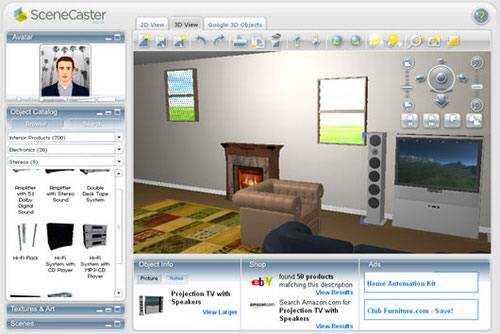Yesterday, when we published our companies to watch list for DEMOfall 2007, Robert Scoble commented that we should have included a company called SceneCaster on our list. “SceneCaster is aimed at Second Life,” he wrote. “But it gets rid of some of the real negatives that Second Life has.”

SceneCaster, which will launch later today, was on our radar, but we didn’t really know enough about it to include it on our list. This morning I got a chance to check it out, and after playing with it for the past hour I don’t think it really is aimed at Second Life. SceneCaster is about creating 3D, virtual spaces, but it’s not a virtual world.
In fact, SceneCaster actually says flat out in their FAQ that they aren’t a virtual world like Second Life:
Is SceneCaster a virtual world?
No. SceneCaster contains fragments of virtual world like spaces but purposely avoids the complexity of virtual world experiences. SceneCaster is designed as an accessible form of immersive 3D media.
Unlike in Second Life, you don’t walk around scenes created in SceneCaster, and they’re not connected into a fluid 3D world. Curiously, SceneCaster’s website includes a number of pictures of characters walking around together in spaces, but there really doesn’t appear to be any sort of utility for actually interacting with others inside scenes, and they imply that there isn’t one in their FAQ.
SceneCaster touts itself as a “3D Web community.” More precisely, it is a simple 3D scene layout program that lets people easily create three dimensional mockups of rooms that can be shared and displayed on the web. “SceneCasterÄôs mission is to mainstream the 3D Web by lowering the barriers to adoption,” said founder Mark Zohar in a press release. “WeÄôve built it from the ground up by combining the very best the Web has to offer today — search, eCommerce and social networking — with a rich, immersive 3D experience that is accessible within a standard Web browser.”

There isn’t much in the way of social networking to SceneCaster, beyond leaving comments on scenes, but creation of scenes is really the main thrust of SceneCaster, and is as simple as advertised — if occasionally frustrating. Using SceneCaster involves installing a plugin for either IE or Firefox. I tested it out in Firefox 2.0.0.7 and ran in to a few stability issues, but in general it was a pretty painless process.
Creating a scene involves dragging premade 3D objects onto a blank canvas (or starting from a template). The application supports Google Sketchup files, which can be imported into your scene via the Google 3D Warehouse. I couldn’t actually get it to work — the app crashed every time I tried — but theoretically that means you could add anything you wanted to your scenes. That makes SceneCaster potentially useful to creative professionals, like architects or interior decorators, who want to easily create and share on the web with clients mockups of their plans.
SceneCaster also includes a bunch of branded content from companies like Kohler, and SmartFurniture. Though there are obvious commercial applications to their technology (i.e., an advertiser could create a remixable space around a specific company), SceneCaster is monetized via ads that appear inside the scene creation app. There are also tie-ins with eBay and Amazon allowing scene creators to purchase the real-world objects that they place in their scenes.
Conclusion
Second Life it is not, but SceneCaster is an interesting product. If they work out the bugs in their scene creation and viewer app, and improve on the controls (changing camera angles or the angle of objects wasn’t as easy as it could be, for example), the app certainly could find a market among creative professionals and 3D enthusiasts. Their mention of social networking in their press release makes me wonder if SceneCaster may be planning more social 3D interaction tools that could be aimed squarely at Second Life.










